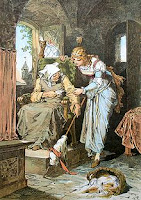There have been many versions of
Little Red Riding Hood through the ages, all with the same basic storyline. The tale rose in popularity when it was reintroduced by the Brothers Grimm in the 19th century.
A girl in a red cloak is traveling through the woods to deliver food to her sick grandmother, when she meets with a hungry wolf. The wolf persuades her to pick flowers for grandma, and races ahead to her grandmother's house. There, he swallows her grandmother whole, dresses up in her clothing, and lies in wait for Little Red Riding Hood so he can eat her too. An huntsman intervenes at the end of the tale, and hacks the wolf to open with a pair of shears, saving Little Red Riding Hood and her grandmother, who climbs out of the wolf's belly.
However, in Perrault's 1697 version, he intended the tale as a warning to young women to avoid sexual predators, he allows the flirtatious Little Red Riding Hood to be eaten. Little Red simply strips naked, gets into bed, and gets eaten up by the big bad wolf, with no miraculous relief from a huntsman.
“From this story one learns that children, especially young lasses, do very wrong to listen to strangers. Alas! Who does not know that these wolves are of all such creatures the most dangerous!”
The wolf represents a sexual predator in the early version, a popular idiom among the audience originally intended to hear this tale (for a girl who lost her virginity) was
"elle avoit vû le loup" which translates to “she has seen the wolf” and Perrault makes this moral explicit at the end.
This tale is perfect for us, as it incorporates an easily accessible location (a forest) and only two main characters, one of which is open to interpretation. This fairytale is widely known by our target audience and would therefore be immediately recognized, and easily relatable. As there have been many versions of this tale, we could add in our own twists without straying from the basic storyline. The
'coming of age' theme would be easy to incorporate as the tale has clear sexual undertones and the
Big Bad Wolf representing a sexual predator, without the graphic details, could also be easily portrayed. Although young women are represented as victims in many versions of this tale, we could challenge this by having our protagonist slay the 'wolf' as to subvert the stereotypical representation of women and make our video empowering.




















































